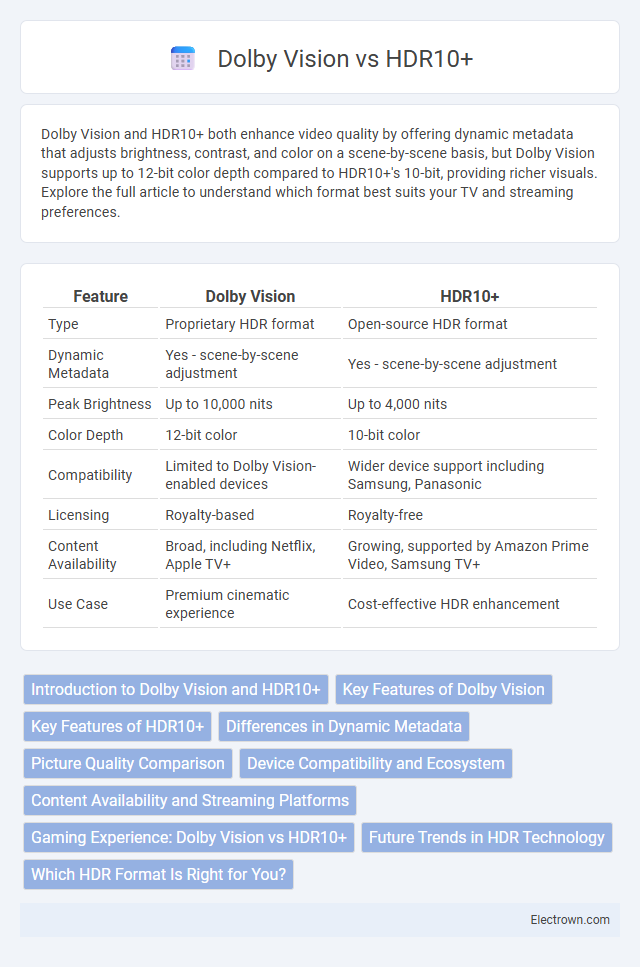Dolby Vision and HDR10+ both enhance video quality by offering dynamic metadata that adjusts brightness, contrast, and color on a scene-by-scene basis, but Dolby Vision supports up to 12-bit color depth compared to HDR10+'s 10-bit, providing richer visuals. Explore the full article to understand which format best suits your TV and streaming preferences.
Table of Comparison
| Feature | Dolby Vision | HDR10+ |
|---|---|---|
| Type | Proprietary HDR format | Open-source HDR format |
| Dynamic Metadata | Yes - scene-by-scene adjustment | Yes - scene-by-scene adjustment |
| Peak Brightness | Up to 10,000 nits | Up to 4,000 nits |
| Color Depth | 12-bit color | 10-bit color |
| Compatibility | Limited to Dolby Vision-enabled devices | Wider device support including Samsung, Panasonic |
| Licensing | Royalty-based | Royalty-free |
| Content Availability | Broad, including Netflix, Apple TV+ | Growing, supported by Amazon Prime Video, Samsung TV+ |
| Use Case | Premium cinematic experience | Cost-effective HDR enhancement |
Introduction to Dolby Vision and HDR10+
Dolby Vision and HDR10+ are advanced high dynamic range (HDR) formats designed to enhance picture quality by delivering greater brightness, contrast, and color accuracy on compatible displays. Dolby Vision uses dynamic metadata to optimize every frame of content for superior visual fidelity, while HDR10+ also employs dynamic metadata but remains an open standard supported by various manufacturers. Choosing between Dolby Vision and HDR10+ depends on your device compatibility and content availability, ensuring your viewing experience is both vivid and immersive.
Key Features of Dolby Vision
Dolby Vision offers dynamic metadata that optimizes picture quality scene-by-scene, delivering superior brightness, contrast, and color accuracy compared to HDR10+. It supports up to 12-bit color depth and peak brightness levels reaching 10,000 nits, enhancing the visual experience significantly. Your viewing is enriched by Dolby Vision's compatibility with a wide range of devices and content, ensuring consistent and immersive HDR performance.
Key Features of HDR10+
HDR10+ enhances your viewing experience with dynamic metadata that adjusts brightness and contrast scene-by-scene, delivering more accurate visuals than standard HDR10. It supports up to 10-bit color depth and 4K resolution, ensuring vibrant colors and sharp details. The format is royalty-free, making it widely adopted across various TVs, streaming services, and Blu-ray discs.
Differences in Dynamic Metadata
Dolby Vision and HDR10+ both use dynamic metadata to enhance picture quality by adjusting brightness, contrast, and color on a scene-by-scene or frame-by-frame basis, but Dolby Vision supports up to 12-bit color depth and uses a proprietary algorithm for more precise adjustments. HDR10+ is an open standard developed jointly by Samsung and Amazon, offering up to 10-bit color depth with dynamic metadata that allows compatible TVs to optimize each frame's HDR performance. Your choice between the two impacts compatibility with different devices and available content, with Dolby Vision often preferred for its higher color precision and broader industry support.
Picture Quality Comparison
Dolby Vision offers dynamic metadata for each frame, delivering superior contrast and color accuracy compared to HDR10+'s dynamic tone mapping, which adapts scene-by-scene but with less precision. Dolby Vision supports up to 12-bit color depth and a peak brightness of 10,000 nits, enhancing picture quality with smoother gradations and richer detail in highlights and shadows. Your viewing experience benefits from Dolby Vision's advanced processing, resulting in more vibrant, lifelike images across compatible devices.
Device Compatibility and Ecosystem
Dolby Vision supports a wide range of devices including TVs, smartphones, Blu-ray players, and streaming platforms, providing a robust and well-established ecosystem with extensive industry adoption. HDR10+ offers growing compatibility primarily on Samsung TVs, Panasonic devices, and select streaming services, but its ecosystem remains more limited compared to Dolby Vision. Device interoperability and content availability favor Dolby Vision, making it the preferred choice for a more diverse and integrated multimedia experience.
Content Availability and Streaming Platforms
Dolby Vision offers broader content availability with support from major streaming platforms like Netflix, Disney+, and Apple TV+, while HDR10+ is primarily featured on Amazon Prime Video and select Samsung devices. Dolby Vision's dynamic metadata allows for enhanced color and contrast adaptation scene-by-scene, which is widely adopted in high-profile movies and TV shows. HDR10+ is gaining traction but remains less prevalent, limiting its content library compared to the more established Dolby Vision ecosystem.
Gaming Experience: Dolby Vision vs HDR10+
Dolby Vision delivers dynamic metadata for every frame, enhancing gaming visuals with superior contrast and color accuracy compared to HDR10+, which uses dynamic metadata but with less precision. Gamers benefit from Dolby Vision's adaptive tone mapping that optimizes scenes in real-time, reducing HDR clipping and preserving shadow details. HDR10+ offers improved brightness and color depth over standard HDR10 but generally lags behind Dolby Vision in delivering consistently vivid and immersive gameplay visuals.
Future Trends in HDR Technology
Dolby Vision and HDR10+ continue to drive advancements in HDR technology by offering dynamic metadata that enhances picture quality on a scene-by-scene basis. Emerging trends emphasize wider color gamuts, higher peak brightness levels beyond 4000 nits, and improved compatibility across devices to deliver more immersive visual experiences. Future HDR developments will likely prioritize real-time content adaptation and AI-powered processing for superior image optimization.
Which HDR Format Is Right for You?
Dolby Vision offers dynamic metadata with frame-by-frame optimization, delivering superior color accuracy and contrast for compatible TVs and streaming services, while HDR10+ provides an open standard with similar dynamic metadata benefits but broader device support at no licensing cost. Choosing the right HDR format depends on your ecosystem: Dolby Vision excels in premium setups like Apple TV and Netflix, whereas HDR10+ is favored by Samsung TVs and Amazon Prime Video users. Evaluate your preferred devices, streaming platforms, and whether you prioritize the widest compatibility or the best possible picture quality before deciding.
Dolby Vision vs HDR10+ Infographic

 electrown.com
electrown.com